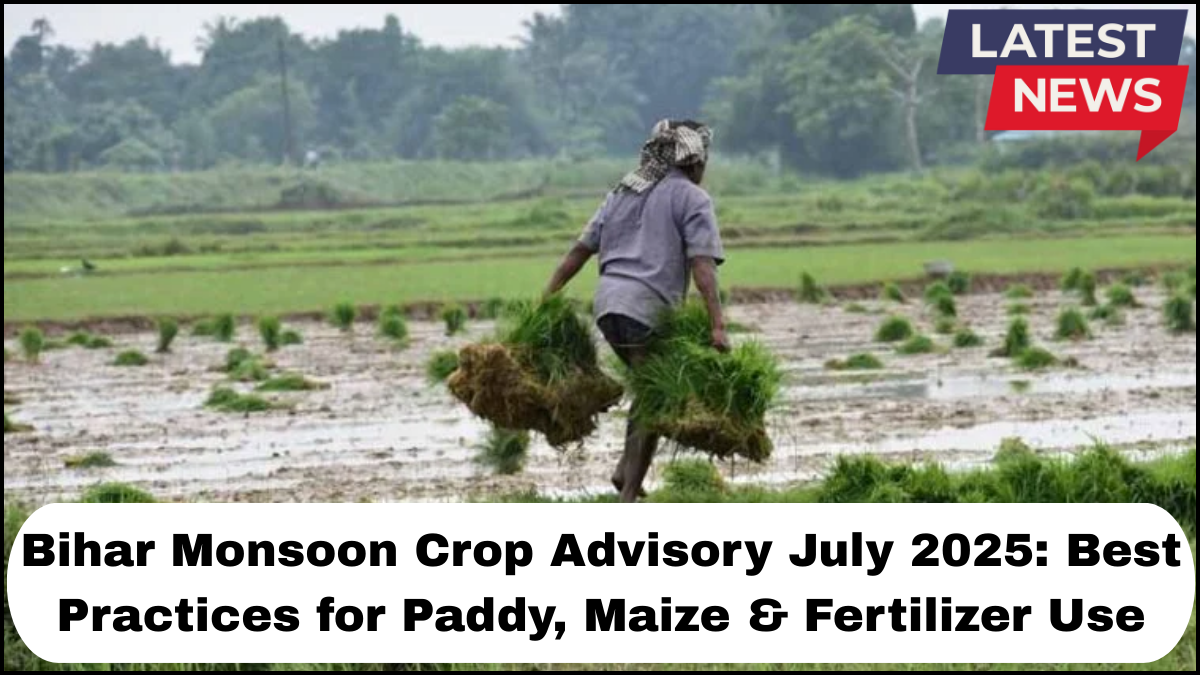The Monsoon Crop Advisory Bihar July 2025 is crucial for ensuring a productive kharif season across the state. As the monsoon rains continue, timely agricultural practices can significantly boost crop yields, especially for staple crops like paddy and maize. This comprehensive advisory outlines the most effective strategies for crop management, pest control, and fertilizer use, offering practical agriculture tips for farmers across Bihar.

Weather Outlook for July 2025 in Bihar
According to meteorological data, Bihar will experience above-normal rainfall during mid to late July 2025. While this is beneficial for water-intensive crops like paddy, excess moisture could also increase the risk of pests and diseases. Farmers are advised to keep drainage systems functional and avoid waterlogging in low-lying fields.
Key Weather Highlights:
- Average rainfall: 280-320 mm across major districts
- Likely increase in humidity and cloudy days
- High soil moisture retention, especially in clay-loam zones
Best Practices for Paddy Cultivation
Paddy being the backbone of kharif agriculture in Bihar requires careful attention during the transplanting and vegetative growth stages in July.
Transplanting Tips:
- Use 21-25 day-old seedlings for optimal yield
- Maintain 20 x 15 cm spacing between plants
- Transplant during early morning or late afternoon to reduce transplant shock
Nutrient Management:
- Apply 30 kg/acre urea 10-12 days after transplanting
- Use 15 kg/acre DAP and 10 kg/acre MOP during field preparation
- Incorporate zinc sulfate (10 kg/acre) in zinc-deficient areas
Weed & Pest Control:
- First weeding should be done 15 days post-transplant
- Use butachlor or pretilachlor-based herbicides after transplanting
- Monitor for leaf folder and stem borer; apply triazophos or cartap hydrochloride if infestation exceeds ETL
Effective Maize Cultivation Techniques
Maize farmers in Bihar need to time their sowing accurately to make the most of the monsoon rainfall. July is ideal for late-sown maize if earlier sowing was delayed due to uneven rain.
Sowing Guidelines:
- Ensure seed treatment with carbendazim and imidacloprid before sowing
- Adopt line sowing with 60 x 20 cm spacing for better air circulation and sunlight
Nutrient Strategy:
- Apply 50 kg urea, 25 kg DAP, and 20 kg MOP per acre at the time of sowing
- Top-dress with an additional 50 kg urea during the knee-high stage
Pest & Disease Advisory:
- Watch for fall armyworm; use pheromone traps and apply emamectin benzoate if needed
- For stem rot, ensure proper drainage and crop rotation with legumes
Smart Fertilizer Use During Monsoon
With high soil moisture, nutrient leaching becomes a major concern during July. Balanced fertilizer application is critical for healthy crop development.
Fertilizer Tips for Monsoon:
- Split nitrogen application to avoid leaching losses
- Avoid urea application right before heavy rains
- Consider using neem-coated urea to slow down nitrogen release
Micronutrient Focus:
- Apply boron in maize-growing belts to avoid tassel development issues
- Zinc and sulfur supplementation is key for both paddy and maize under high rainfall conditions
Additional Agriculture Tips for Farmers in Bihar
- Regularly clean field bunds to prevent pest breeding
- Maintain proper field drainage to control fungal infections
- Incorporate green manure or cow dung slurry to boost organic matter
- Stay in contact with local Krishi Vigyan Kendras (KVKs) for real-time updates
FAQ: Monsoon Crop Advisory Bihar July 2025
Q1. When is the best time to transplant paddy in July 2025?
Early to mid-July is ideal, especially after receiving consistent rainfall. Ensure soil moisture is adequate but not waterlogged.
Q2. How to protect maize from fall armyworm during the monsoon?
Use pheromone traps and adopt IPM (Integrated Pest Management). Apply emamectin benzoate if infestation crosses the economic threshold level.
Q3. What are some natural ways to improve soil fertility during the monsoon?
Use compost, green manure (like dhaincha), and biofertilizers to enrich soil organically.
Q4. Can excessive rainfall reduce fertilizer effectiveness?
Yes. It can lead to nutrient leaching, especially nitrogen. Split applications and coated fertilizers are recommended.
Q5. Where can farmers get real-time support for crop management?
Local agriculture officers, KVKs, and state agriculture department helplines provide timely support.
click here to learn more